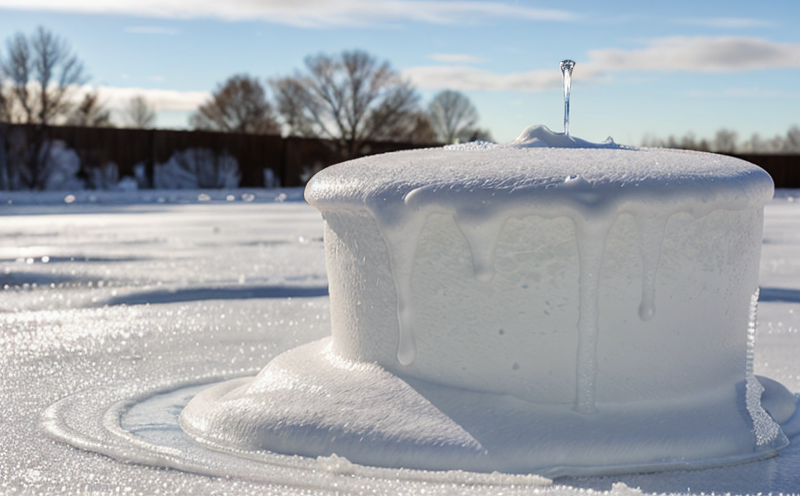SAE AIR 4361 In-Flight Ice Accretion Simulation Testing
The SAE AIR 4361 in-flight ice accretion simulation testing is a critical component of the aerospace and aviation industry. This test evaluates an aircraft’s ability to function effectively under icing conditions, ensuring safety and reliability during flight operations. Icing can significantly impact aerodynamic performance, control surface effectiveness, and overall structural integrity. By simulating these conditions on the ground, engineers and quality managers gain valuable insights into how their designs perform in real-world scenarios.
The SAE AIR 4361 test is conducted using specialized equipment that replicates the environmental conditions typically encountered during flight through clouds containing supercooled water droplets. The process involves exposing the aircraft model or component to controlled levels of artificial ice accretion, closely mimicking the natural formation of ice on aircraft surfaces.
One of the key challenges in this testing is achieving accurate and repeatable results that reflect actual in-flight conditions. To address these challenges, SAE AIR 4361 outlines specific guidelines for specimen preparation, exposure duration, and measurement techniques to ensure consistent and reliable data collection. Proper sample selection and handling play a crucial role in ensuring the validity of the test results.
The testing procedure typically involves several stages: initial conditioning, ice accretion simulation, and post-test evaluation. During the initial conditioning phase, the specimen is prepared according to SAE AIR 4361 specifications, including cleaning, drying, and marking for subsequent analysis. The ice accretion simulation follows, where the test chamber simulates flight through clouds containing supercooled water droplets. Post-test evaluation involves assessing the extent of ice accretion on the specimen’s surfaces and comparing it against predefined acceptance criteria.
Accurate and reliable data collection is essential for validating the test results and ensuring compliance with regulatory requirements. SAE AIR 4361 specifies precise methods for measuring ice accretion, including weight determination and surface area assessment. These measurements provide critical information on the distribution and thickness of ice formed on different parts of the aircraft or component.
By conducting this simulation testing, manufacturers can identify potential design flaws or material weaknesses that could compromise safety during flight operations. The insights gained from SAE AIR 4361 testing enable continuous improvement in aircraft design and materials selection, ultimately enhancing overall performance and reliability under icing conditions.
Applied Standards
| Standard | Description |
|---|---|
| SAE AIR 4361 | This standard specifies the procedure for simulating in-flight ice accretion on aircraft components and systems to evaluate their performance under icing conditions. |
| American Society for Testing and Materials (ASTM) | Detailed procedures for testing materials, products, and systems used in the aerospace industry, often referenced for additional validation. |
Why Choose This Test
- Precision simulation of real-world icing conditions.
- Comprehensive evaluation of aircraft performance under icing scenarios.
- In-depth analysis of ice accretion on critical components and systems.
- Enhanced safety assurance for flight operations in challenging weather conditions.
- Regulatory compliance with international standards.
- Supports continuous improvement in design and material selection.
- Accurate data collection for informed decision-making.
Quality and Reliability Assurance
The SAE AIR 4361 ice accretion simulation testing plays a vital role in ensuring the quality and reliability of aerospace components and systems. By simulating flight through clouds containing supercooled water droplets, this test provides critical insights into how aircraft perform under icing conditions. This information is invaluable for identifying potential design flaws or material weaknesses that could compromise safety during flight operations.
The testing process involves several key stages: initial conditioning, ice accretion simulation, and post-test evaluation. During the initial conditioning phase, specimens are prepared according to SAE AIR 4361 specifications, including cleaning, drying, and marking for subsequent analysis. The ice accretion simulation follows, where test chambers replicate flight through clouds containing supercooled water droplets. Post-test evaluation involves assessing the extent of ice accretion on different parts of the aircraft or component.
Accurate and reliable data collection is essential for validating test results and ensuring compliance with regulatory requirements. SAE AIR 4361 specifies precise methods for measuring ice accretion, including weight determination and surface area assessment. These measurements provide critical information on the distribution and thickness of ice formed on various surfaces.
By conducting this simulation testing, manufacturers can identify potential design flaws or material weaknesses that could compromise safety during flight operations. The insights gained from SAE AIR 4361 testing enable continuous improvement in aircraft design and materials selection, ultimately enhancing overall performance and reliability under icing conditions.





